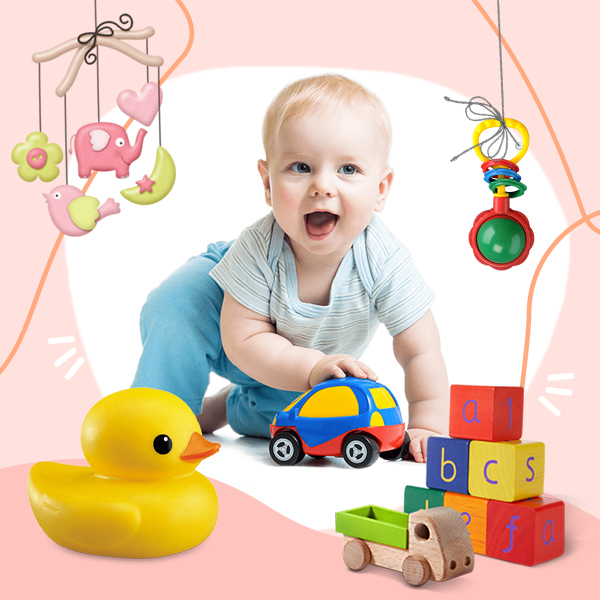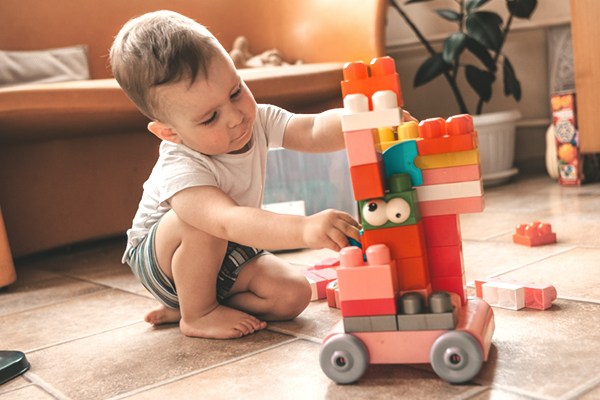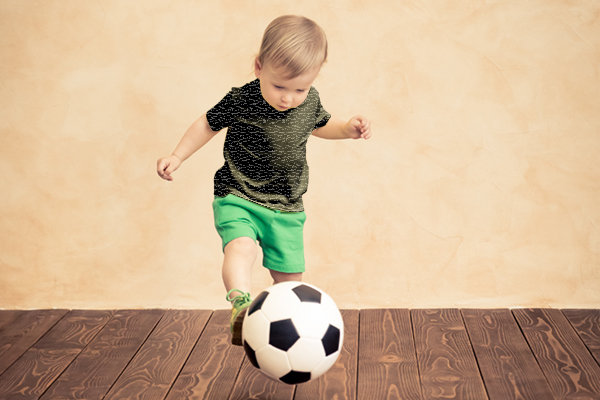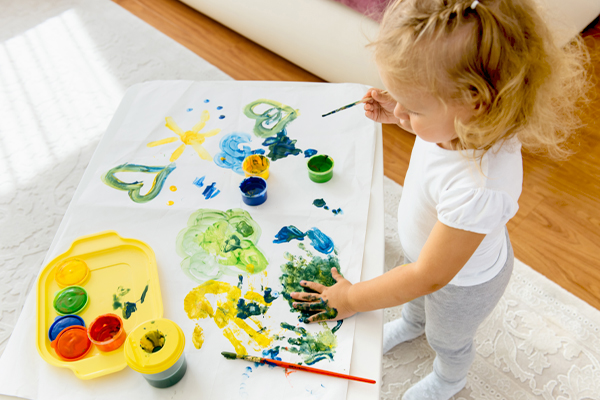Staying busy caring for their toddlers' health, hygiene, and moods, parents sometimes overlook the need for healthy stimulation. Because aged one-and-a-half years, these kids’ brains are rapidly forming new connections within and laying the groundwork for their cognitive abilities in the lifetime that follows. If you’re a confused parent in charge of a toddler, below are our favorite picks for the most engaging activities for 18-month-olds and information to help you understand why they matter.
Creative Play
Promoting creative abilities is an integral part of a healthy development program for your child. Children are often inclined to be creative independently, regardless of their abilities. This can take the form of problem-solving or simple expressions of their tastes and ideas in different mediums, artistic or otherwise.
Get Doodling
Kid-friendly chalks of any color imaginable can give your 18-month-olds a chance to express themselves or replicate their favorite animal or cartoon characters. While chalk or simple pencil doodling offer relatively limited leveling and interactiveness, they are staple forms of creative activities for 18-month-olds owing to their simplicity and convenience.
Encourage Pretend Play
Parents can increase the level of interaction by encouraging the child to use their imagination to play with toys like model tortoises or
squirrel gifts, a teddy bear, or a cool white elephant plushie. If you’re the playtime partner, you can chip in with scenarios of your own or simulate needs and moods on behalf of the toys!
Explore Spices
Many parents underestimate the potential of spice exploration activities. Getting the child to separate the contents of a mixed tray of rice, cardamom, cloves, and dry beans can make for a no-mess puzzle activity. However, you’ll have to keep a keen eye trained to prevent ingestion or inhalation.
Match-The-Shape Blocks
For kids whose supervision is challenging to manage, a shape block-and-slot contraption can also serve as an exercise for hand-eye coordination and cognitive skills while being catchy as a fun indoor activity for 18-month-olds!
Sensory Experiences
Engaging the senses at intensities slightly higher than routine activity can go a long way toward helping the child develop a stable and sharp nervous system.
Playtime With Sensory Toys
Toys like Play-Doh, slimes, stuffies, and some particularly squishy
SpongeBob gifts do a great job addressing the need to incorporate a fair bit of engagement of the senses in indoor activities for 18-month-olds.
Getting Things Done
Some little humans are more eager to imitate grown-ups, and the realization that they are playing with toys might be off-putting. In these cases, alternative activities for 18-month-olds, like long bubble baths, gardening sessions, and practicing with miniature musical instruments, come in handy.
Hunt For Treasure Together
Introduce your toddler to toys with bumpy, rubbery surfaces or soft objects in bright colors like
red gifts, electric blue, or shocking pink. Then, stash them around the playroom and help the child rediscover them to emphasize the sensory importance of each.
Physical Activity
Once developed, moving around and learning to use their bodies as tools of function and expression is a lifelong skill. Traditionally, children around 18 months of age are made to interact with tools that help them stand up and subsequently walk, but physicality in young children can enable them to enhance many more of their skills.
Playdates With Squishy Mates
Set Up a Pom-Pom Dropping Station
For children who aren’t fond of moving around too much, a Pom-Pom drop activity can be a relatively lighter exercise for fine and gross motor coordination, grip, and tactile sense.
Take Them on a Walk
Where an excellent old-fashioned stroll outdoors is possible, it is the ideal physical activity for 18-month-olds to help them work on their movements, socialize, and interact with a vast and dynamic environment.
Cognitive Skills
Sorting objects by color, texture, or shape is fundamental for cognitive development in one-and-a-half-year-olds. If your kid seems to be getting past this basic regimen and you’re looking for more fun indoor activities for 18-month-olds, it might be time to start learning the alphabet or numbers. But that doesn’t sound like a fun activity, does it? Well, with a bit of planning, it can be. Remember, the fundamental objective is to train the brain to absorb, organize, and store information, not the content they memorize.
What’s in a Name?
Animals, fruits, and vegetables are all symbols that kids associate with words, i.e., their names. With toys or
figurine gifts to go along, the associations can be taken up to a whole new level. For instance, you can give your child a set of Teenage Mutant
Ninja Turtle gifts and start by having them memorize the beloved turtles’ names and match them with their bandana colors. Songs and rhymes can help the child learn things in order and reinforce the growth of their language centers.
Social Interaction
This may be the most challenging part of the process for parents and their young ones alike, but knowing that a lack of social skills has nothing to do with intelligence or ability to perform is essential.
Playgroups
Most children aged between one and two years are happy with playdates and trips to the park. They welcome any opportunity to play with peers, as a team, or as opponents. Board games, card games, pretend play, and simply sharing toys are all forms of socialization for 18-month-olds
Let Them Be the Audience
Activities for 18-month-olds who are timid can take some extra planning because the best way to start them off is with a one-sided conversation. This can be in storytelling at home or the local library with kids of the same age group. One-sided socialization eventually encourages the child to respond or react, letting them figure out how to express emotions and ideas best. Popular shows like Dora the Explorer are examples of this, where loving young fans can be seen responding to TV screens worldwide.
Now that we are done discussing all the options for activities your 18-month-old can partake in to ensure ideal development, let us shift our focus to all the toys and equipment you can use to make these activities doubly attractive and engaging for your child!
Activity cubes are toys designed as conglomerates of stimulating activities for 18-month-olds, with a different one on each side. They are usually made of wood, but every cube offers a unique combination of activities.
Dino Toys are iconic interactive playthings that are very popular among parenting coaches for their value and simplicity. Children can interact with the toy and get it to narrate information like colors, shapes, numbers, and letters. Alternatively, they can simply play pretend games using their imagination to manipulate the full-fledged model dinosaur!
Essentially a mini-catalogue of information, Word Books might not seem very attractive to children, but you will be surprised to see the design techniques and tricks manufacturers employ to turn them into fun toys.
Kids can construct pretend buildings using Building Blocks, sets available in themes ranging from Lego to
Harry Potter gifts and everything in between. These help calibrate the toddlers’ fine motor skills, planning skills, and understanding of their environment.
A colorful bouquet of soft, safe projections with a cutesy face. What more could a young mind want? 18-month-olds are incredibly fond of the Fine Motor Hedgehog as a toy. It seems there is just something comforting and loveable about the ‘safe’ counterpart of a creature children rarely get to see and are never allowed to approach.
FAQs:
Q: How much time a day is adequate for these activities?
Reading a child’s cues is the best way to determine a time span for their activities. If the child seems deeply involved for five to ten minutes, take this as a good sign. Let the activity go on for as long as the mood seems stable. Twenty minutes per activity is more than enough to encourage healthy growth.
Q: Are digital learning and development aids safe for kids?
When using digital tools as activities for children aged around 18 months, parents should be careful about limiting two things: time span and freedom to navigate. Prolonged sessions spent interacting with digital devices can adversely affect the child’s dopamine cycles and cause nausea or even damage to eyesight and hearing.
Q: Should I be concerned about hygiene during these activities?
Of course! Cleanliness and safety have to be prioritized at all times. But, having stated that, parents and guardians need not worry about mud, puddles, grass smudges, animal or artificial fur, and paint spills unless the family doctor has issued specific warnings. Where the child has interacted with such elements, it’s always a good idea to bathe using antibacterial soaps.



